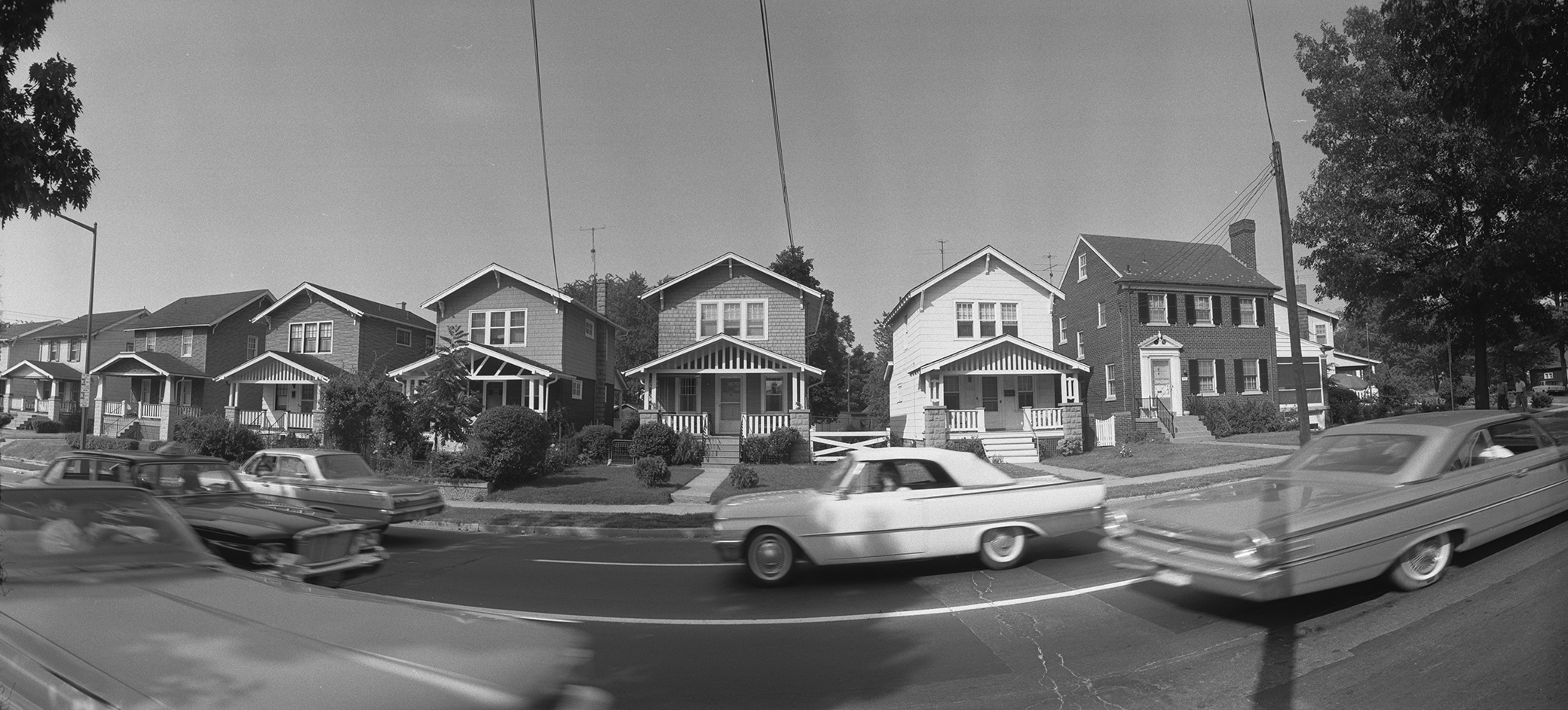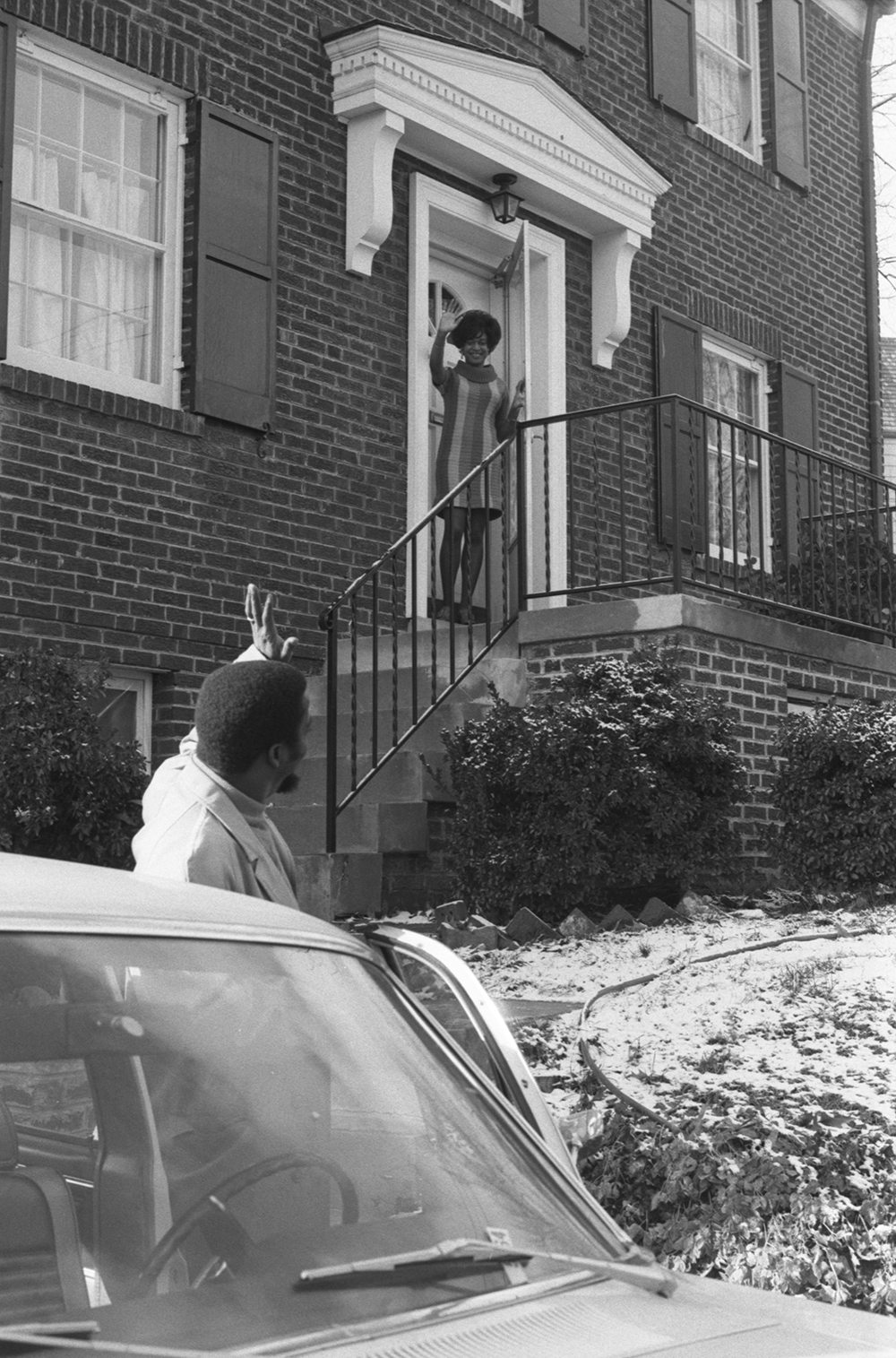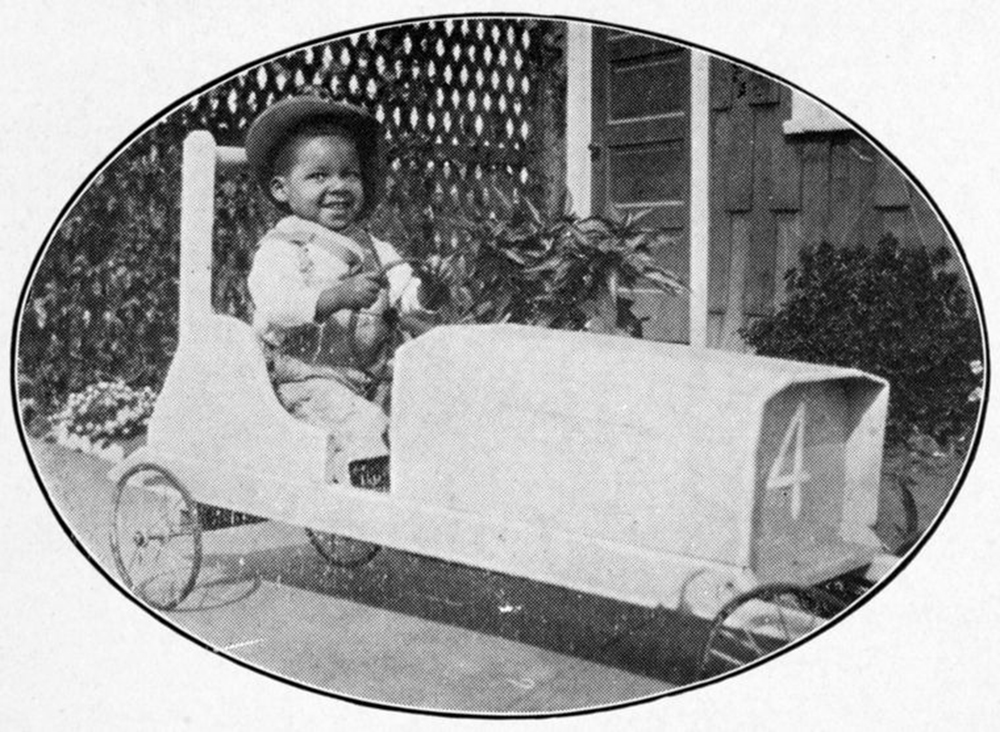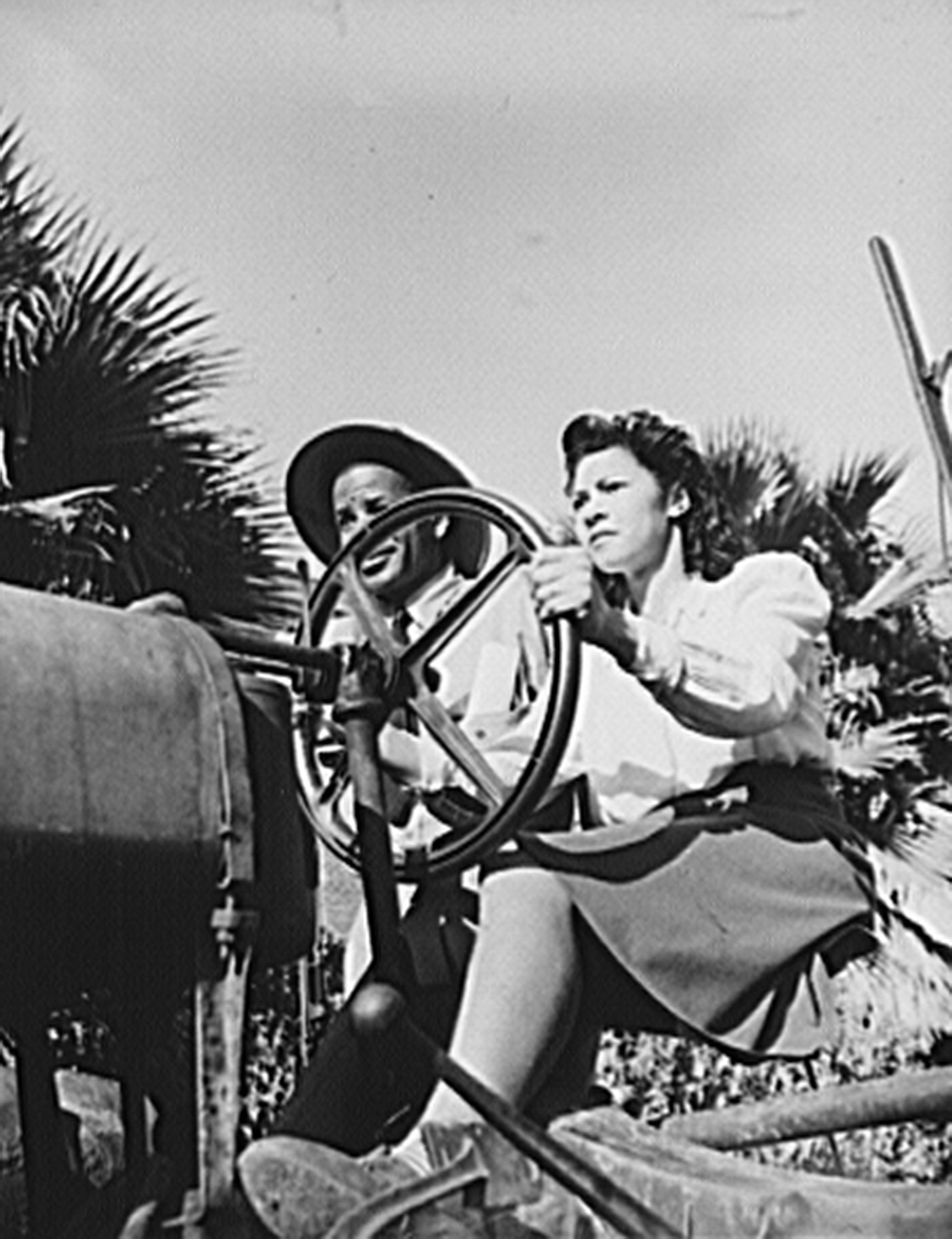
Cars pass homes in an African American neighborhood, South Dakota Avenue NE, Washington, DC, 1963. Photograph by Thomas O'Halloran. Library of Congress, Prints and Photographs Division.
Between the 1920s and the 1960s, automobile ownership changed African American life. You could not be asked to move to the back of the bus—or, worse, to get off and reenter through the back door—if you drove your own car. The horsepower of an automobile also gave African American drivers the ability to escape. Cars enabled motorists to move rapidly without being stopped or harassed by white citizens anxious to take the law into their own hands. There are instances of African Americans being dragged from their cars and beaten by angry mobs, but there are certainly far more cases of black people simply driving past whites without being detected or of outrunning a dangerous situation. Getting behind the wheel became, at times, an equalizer.
Emily Post, the arbiter of white America’s etiquette, expressed concerns that cars leveled the social playing field. She complained about the ordinary citizen who purchased a new car and “felt that he automatically became the equal of every owner of a similar car, and the superior of the owners of all cars of less importance.” The car, Post feared, enabled the lower classes to feel equal to the middle classes. Post further lamented that “the man in moderate circumstances will stint himself in every way to buy a car actually beyond his means, thus to gratify his desire to go one better than his neighbor.” Not only did cars make you more equal, she continued, but they could make you more confident and aggressive. Post saw the automobile as an unfortunate invention for those, like herself, who wished to preserve the existing social order. Others, however, especially African Americans, viewed the automobile as the necessary invention of a democratic society.

W.E.B. Du Bois, editor of The Crisis, the magazine of the NAACP, traveled throughout his life for both business and pleasure. As a sociologist, civil rights activist, and speaker, he spent many hours on the road. Sometimes he traveled by Jim Crow train car, but, tellingly, he preferred his own automobile. Most African Americans who could afford cars purchased them. And many had a special relationship with their cars.
Du Bois clearly loved driving, especially in his old, reconditioned car. In 1932 he drove all the way from New York to the site of a contentious coal miners’ strike in Harlan County, Kentucky. “All over and everywhere the colored people are traveling in their automobiles,” he wrote in a 1932 column in The Crisis. He seemed quite pleased with the increasing number of black car owners, noting that car ownership was a particular boon to businessmen—insurance agents, officials of fraternal and religious societies, and the like. With great satisfaction, he commented on the positive way that the automobile changed transportation for one member of the black elite, a prominent clergyman:
I remember once that the venerable Bishop Turner, stricken with paralysis, could for neither love nor money, hire a Pullman berth from Savannah to Atlanta. They fixed the old man up in the “Jim Crow” smoker across two seats. Yesterday I saw the A.M.E. Bishop of Florida. He was gliding along in his Cadillac car with a chauffeur on the way from Jacksonville to Atlanta. He looked extremely comfortable.
Furthermore, Du Bois took great delight in the fact that car travel seemed to be putting a damper on certain businesses that supported the Jim Crow system. “[T]he only discrimination that we chanced upon was one at which we heartily laughed: a filling station on the Jacksonville–Daytona road had a sign ‘For white trade only.’ We passed it four times and saw no single car there. ‘These crackers persist in being fools!’ says my companion.”
While all Americans—white and black—enjoyed the freedom and privacy that the automobile afforded, these advantages were far more profound for black Americans. “Of course Negroes ride in the Jim Crow coach here,” commented a wealthy black man from North Carolina. “But I don’t ride in it; I just don’t ride trains now. I use my car and drive anywhere I want to go. That’s one of the reasons I have a car.” Operating a motorcar proved to be a wonderful, liberating experience for citizens for whom the full rights of citizenship and mobility were denied. The automobile opened up the entire nation for exploration, emboldening black people to visit national parks and monuments, historic sites and museums, and to take vacations or just go for a drive. “We feel like Vikings,” exulted Alfred Edgar Smith, an African American journalist and administrative assistant for the federal Works Progress Administration. “What if our craft is blunt of nose and limited of power and our sea is macadamized…The nomad in the poorest and the mightiest of us, sends us behind the wheel, north, south, east, and west, in answer to the call of the road.”
Assuming the role of “Vikings” appealed to black travelers because of the many prohibitions on mobility, historical and contemporary. Drivers relied only on themselves when traveling by car. Willie Cooper, whose first car, “Old Betsy,” was a key-lime 1956 Buick, refused to give up his driver’s license at the age of seventy-five. “He wants to drive,” said his daughter, Detroit News reporter Desiree Cooper, “because he has a right to—and he’s earned it.”
The newfound freedom offered by the automobile, however, also brought black Americans—as it did not for white Americans—into contact with new dangers. Black drivers could venture unwittingly into the wrong neighborhoods or stop at the wrong places. Despite these potential perils, families and business travelers continued to drive into unknown regions and across state lines. Black motorists encountered racist law-enforcement officers, racist gas-station attendants, bigoted automobile repairmen, threatening road signs, and restaurants that would only serve food to black patrons through a window slot in the back door. Sometimes black motorists even faced the anger of racist mobs. Driving a car through unfriendly and even hostile neighborhoods and all-white communities represented a small yet meaningful personal act of bravery—a statement of rebelliousness and refusal to accept the status quo or to give in to fear.

Cars allowed for these encounters not only because they permitted more freedom of movement but also because they offered a measure of safety to the driver and passengers. Parents traveling with children in a car could more adequately protect their offspring from the verbal and psychological battering that could accompany a ride on a public conveyance. Historian Spencer Crew reminisced about growing up in the 1950s: “That big old car was like a cocoon,” he remembered. “We didn’t know anything except what we saw out the side windows. We could hardly see over the back of the front seat. Our parents protected us from all the racist stuff along the road.” Children were able to grow up proud rather than ashamed of their identity, without the public assaults that could accompany bus and train travel. A car could move you from one African American neighborhood—or safe zone—to another, enclosed in your own rolling living room. It was “a racial shield.”
In his study of African Americans in rural Georgia, ethnologist Arthur Rapier found that black travelers used their automobiles not only as a way to evade the “irritations of the unequal transportational facilities provided by train and bus and plane” but also as a method of resistance to a racist system. Rapier’s informants, and by extension black people elsewhere, understood that they could eschew the racist public transportation system and help starve it of money by using their cars. At the very least, they denied the operators of buses and trains fares to support racist practices.

Du Bois wrote a detailed description of a 1929 trip he made throughout the South to understand what it was like to travel the region as a black person. He traveled 1,399 miles—by Pullman car, Jim Crow car, and automobile. The trip illustrated the unpredictable nature of the conditions that African American travelers encountered. From Petersburg, Virginia, to Raleigh, North Carolina, he found the Negro coach “not as modern a coach as that of the white,” but it was clean, and he noted that the conductor said, “Please.” From Hamlet to Charlotte in North Carolina, however, a trip of seventy miles, he rode in “a miserably dirty car which any decent State Board of Health would have condemned.” The number of African Americans driving automobiles, even at this early date, proved a total surprise to him, but a welcome one. Du Bois’ anecdotal observations suggested that the automobile was having an effect on Jim Crow segregation, denying it funds. “My chief joy,” he wrote, “in these ‘Jim Crow’ rides was those empty cars. The automobile is certainly bringing just retribution upon the silly profiteering of Jim Crow.” The car could also play a more direct role as a weapon against Jim Crow, as it did during the 1955–56 Montgomery bus boycott and similar acts of open defiance.
Selecting that perfect car could be a challenge for every American family, but the calculus was different for African Americans. Black families in the South, or ones with southern connections, needed a car that would provide a safe and secure ride in a Jim Crow environment. Pontiacs offered “roomy” and “trouble-free performance.” The greatest attribute of Studebakers, aside from their airplane-like appearance, was their durability. Ford claimed to offer the most affordable cars on the road, with “comfortable tweed interiors,” generous seats, and fashionable new colors like sea-mist green and bay-view blue. Black magazines, newspapers, and travel guides like The Negro Motorist Green Book offered advice and periodic profiles of the latest automobile models to help their readers select the most serviceable makes and models. The choice could make the difference between a safe journey and a dangerous confrontation. Black buying power, vehicle selection, and even driving practices were all sharply determined by discrimination. Black families had specific criteria for selecting cars and very specific needs when they went out on the road.
For many drivers, safety surpassed all other measures. The terrible saga of the civil rights activist Medgar Evers offers a case in point. Evers hoped to become a lawyer, so, in the summer of 1954, with a bachelor’s degree from Alcorn Agricultural and Mechanical College (now Alcorn State University), he applied for admission to the law school at the University of Mississippi. He received a rejection letter, because “Ole Miss” did not accept black students in the 1950s. Instead Evers became the first field director for the NAACP in the state of Mississippi. This new job involved driving all over the state on back roads and in isolated rural places to gather evidence of arson, to investigate murders, and to examine other crimes committed against black residents that were ignored by the local police because of the victims’ race. Evers knew well the dangers of the job and the hostile attitudes toward the NAACP held by many white Mississippians. They viewed him as a racial agitator, stirring up the accepted social order. Working for the NAACP could get you lynched or shot. Despite the precautions Evers took, white supremacist Byron De La Beckwith would murder him in his own driveway in 1963.
A black man—particularly a black man driving the back roads of Mississippi—had to think long and hard about which car to buy. Special concerns, such as how comfortable a car would be for sleeping or how easily it would allow a quick escape from an angry mob, generally did not concern white drivers. Evers selected a large and imposing Oldsmobile with a V-8 engine for his excursions around the state. The car’s utilitarian body design belied the power under the hood. The engine—the Rocket 88—was a precursor of the muscle car that high school boys, with cigarettes rolled in their T-shirt sleeves, would covet in the late 1950s and 1960s, but for Evers it was a practical rather than an ostentatious choice. The Rocket 88 would not be pushed around or shoved from the road by a less powerful car or a pickup truck, and Evers’ long frame could stretch out on the seat to sleep if need be. Most important, when you pressed the accelerator, that “Olds” took off and could outrun an ambush.
Adapted from Driving While Black: African American Travel and the Road to Civil Rights by Gretchen Sorin. Copyright © 2019 by Gretchen Sorin. Used with permission of the publisher, Liveright Publishing Corporation, a division of W.W. Norton & Company, Inc. All rights reserved.
